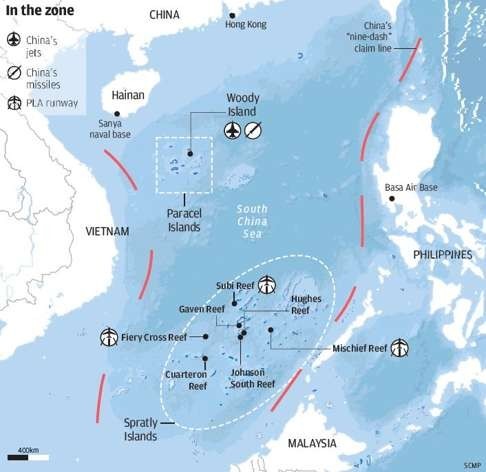The Background
Two recent close encounters between U.S. spy planes and Chinese jets spell trouble for relations between Washington and Beijing. The first occurred over the South China Sea (SCS) near China’s Hainan between a US EP-3 spy plane and two Chinese jets, strikingly similar to the 2001 incident in the same area in which a Chinese jet and an EP-3 collided, resulting in the death of the Chinese pilot, the forced landing and detention of the U.S. crew, and a tense diplomatic row. The second involved a U.S. RC-135 plane that was closely tracked by a Chinese jet over the East China Sea (ECS). Such incidents, which also bring U.S. and Chinese ships in close proximity, are happening with greater frequency these days. Two reasons: China is backing its claims of “indisputable sovereignty” over the islands—the Spratlys (Nansha) and Paracels (Xisha) in the SCS, Diaoyudao (Senkaku) in the ECS—with military construction and personnel, and U.S. naval and air maneuvers are deliberately challenging Chinese activity. Leaders of both countries are now issuing thinly veiled warnings, demanding acceptance of their respective positions and disputing details of the encounters.

The Chinese fighter jets that intercepted a U.S. reconnaissance plane over the East China Sea on June 7 were J-10s, like these two from a Chinese aerobatics team. PHOTO: NARONG SANGNAK/EUROPEAN PRESSPHOTO AGENCY
The dispute cannot be separated from other developments, domestic and international, involving the U.S. and China. In the American case, those developments surely include the presidential campaign politics, in which tough posturing on China is expected of the candidates; the Pentagon’s dismissal of Chinese claims by announcing it will send naval and air forces anywhere it chooses; and alliance politics, particularly in support of the Philippines and Japan (which has its own close encounters with Chinese vessels in the ECS) but also in strengthening ties with Vietnam and India. The Chinese position is influenced by rising nationalism; Taiwan’s election of a new leader from the opposition Democratic Progressive Party, leading to pressure by Beijing to insure against a declaration of independence; pro-democracy activism in Hong Kong, most recently fueled by China’s seizure of five Hong Kong booksellers contrary to law; and the Beijing leadership’s assault on civil society, which has created a backlash against President Xi that surely troubles his inner circle. These are all sources of actual or potential pressure on political leaders not to stray from their tough stances on international issues.
Containment of China?
Like the Philippines, Vietnam is a big fan of a larger U.S. military presence in Southeast Asia. How ironic that the one-time U.S. base at Cam Ranh Bay may soon be regularly visited again by the U.S. Navy for resupply, while U.S. multinational corporations eagerly pursue investment opportunities—this, despite Vietnam’s serious human rights problems and growing rich-poor divide. In return for U.S. access, Obama announced an end to the U.S. embargo on arms sales to Vietnam at the time of his visit to Vietnam in late May. Though he explicitly stated that the decision was part of normalization of relations with Vietnam and unrelated to China, of course it had everything to do with reining in China (and, unfortunately, set aside U.S. human-rights concerns).

The official Chinese response to the U.S.-Vietnam agreement was subdued; a foreign ministry spokeswoman said China “welcomes normal relations between Vietnam and the United States” (Harris). Likewise, the China Daily found nothing amiss in Obama’s agreement, but only so long as China’s interests are not harmed:
It is worrying to note the three-day visit has been described by some as a pivotal move in the US’ strategic rebalancing to curb the rise of China. The US, they say, is using Vietnam as an offset to China’s growing strength in the region, especially after tensions increased in the South China Sea because of regional countries’ competing sovereignty claims. This, if true, bodes ill for regional peace and stability, as it would further complicate the situation in the South China Sea, and risk turning the region into a tinderbox of conflicts. (China Daily)
India is a newcomer to U.S. maritime strategy, though you will not find the Pentagon officially classifying India as a partner in containing China. But how else can one interpret India’s signing of “a Joint Strategic Vision for the Asia-Pacific and Indian Ocean region with the United States, a Special Strategic and Global Partnership with Japan and a Framework for Security Cooperation with Australia,” frequent visits to India since 2008 by U.S. defense secretaries, a pending logistics support agreement that would enable repair and resupply of U.S. air and naval forces on Indian territory, and official Indian statements with the U.S. and Southeast Asian countries about the “destabilizing” effects of (read China’s role in) the South China Sea dispute? As U.S. relations with Pakistan deteriorate—the drone strike that killed the Taliban leader on May 21st was conducted without Pakistan’s approval—ties with India become more crucial to Washington.
Though no one is talking about a formal alliance, cooperative ties with India, highlighted by Prime Minister Nahendra Modi’s visit to Washington in June, stretches U.S. military arrangements around China’s rim, notably with a longtime adversary of China’s. During his visit, Modi was quite effusive about mutual security concerns, among them “freedom of navigation on seas.” Analysts in Beijing surely did not miss that reference.
Getting to “Yes”
China’s leaders should also pay attention to the thinly veiled criticism of its actions by the G7 meeting in Japan on May 26-27 and the IISS Shangri-La Dialogue from June 3rd-5th. Though the G7 Leaders’ Declaration does not specifically mention China and does not deal with maritime security until nearly the end of the document—it is buried on page 25 of the 32 total pages—it leaves no doubt about its target:
We reiterate our commitment to maintaining a rules-based maritime order in accordance with the principles of international law as reflected in UNCLOS [United Nations Convention on the Law of the Sea], to peaceful dispute settlement supported by confidence building measures and including through legal means as well as to sustainable uses of the seas and oceans, and to respecting freedom of navigation and overflight. We reaffirm the importance of states’ making and clarifying their claims based on international law, refraining from unilateral actions which could increase tensions and not using force or coercion in trying to drive their claims, and seeking to settle disputes by peaceful means including through juridical procedures including arbitration. We reaffirm the importance of strengthening maritime safety and security, in particular the fight against piracy, through international and regional cooperation. We are concerned about the situation in the East and South China Seas, and emphasize the fundamental importance of peaceful management and settlement of disputes. (ISE Shima Summit).
China’s foreign ministry responded by reiterating its standing position on sovereignty and rejecting outsiders’ involvement in the territorial dispute. The spokesperson made the unsupported statement that “more and more countries and organizations” agree with China’s position. The ministry condemned the G7 declaration, saying it went beyond the organization’s purposes and did not contribute to peace and stability. China, it said, will be holding a G20 meeting that is “more representative” to focus on the world economy (People’s Daily).
The annual Shangri-La Dialogue produced much the same discord, with China coming up for considerable criticism from Southeast Asian countries as well as the U.S. Against the background of an anticipated ruling against China by the Permanent Court of Arbitration, which will rule on the legal validity of Chinese claims (not the sovereignty issue), the Chinese delegation—again led by Admiral Sun Jianguo, a deputy chief of the Joint Staff Department under the Central Military Commission—rather heatedly contended that China would not recognize or comply with the court’s ruling. He denounced the Philippines for violating a bilateral agreement with China by submitting the dispute to the court (Sun Jianguo). Sun was particularly upset with U.S. defense secretary Ashton Carter’s assertion that China is erecting “a great wall of self-isolation” (IISS Asia Security Summit). His speech, as well as a milder PRC foreign ministry comment (Hao), sought to pin the blame for all the trouble on U.S. “ulterior motives.”
A Shared Responsibility
Both the U.S. and China must bear responsibility for the ratcheting up of tension in the SCS and East China Sea. Washington clings to “freedom of navigation” as its principal reason for challenging Chinese claims even though unencumbered passage has not denied U.S. or any other country’s ships. U.S. “show the flag” maneuvers are a clear provocation that the Chinese cannot but answer. The PRC foreign ministry and various Chinese officials have issued reassurances about freedom of navigation, saying it is China’s duty to protect it as the region’s main riparian state as well as in conformity with international law. Moreover, while the U.S. takes no official stand on sovereignty, its increasingly close military ties with the Philippines, Vietnam, Japan, and India are defining a U.S. security interest that did not previously exist. Finally, as the Chinese are quick to remind everyone, the U.S., unlike China, has failed to sign and ratify the UNCLOS, which dilutes the frequent American argument on behalf of a common “rules-based” approach to the dispute.
On the Chinese side, the stubborn insistence on an unassailable historic right to the islands, and an absolute refusal to adhere to whatever decision the arbitration court reaches, are weak positions at best. The insistence that China’s strategic purpose in building runways, ports, and supply facilities in the SCS is defensive no doubt refers to the Yulin nuclear and ballistic missile submarine (SSBN) base and other submarine and surface ships harbored on the southern end of Hainan Island (National Interest). But while US spy planes do keep watch on Chinese activities there, there is no credible threat to that base, at least so long as it is not for offensive operations. So that leaves open the question of how far China intends to go with its SCS buildup. One prominent Chinese analyst notes that when Xi Jinping promised President Obama that China would not “militarize” the SCS when Xi visited Washington in September 2015, he really meant “small and limited military facilities that are simply for defensive purposes.” But what we are witnessing, and what is distressing China’s neighbors, is a buildup that looks increasingly aimed at creating permanent bases. (Zhu Feng, “Are China and the US Headed for Confrontation in the South China Sea?” Global Asia, vol. 10, No. 4 (Winter, 2015), pp. 60-64)
The latest close calls, and war of words, need not lead to an open collision. But they certainly are worrisome. U.S. naval and air probing of China’s SCS buildup, and Chinese land reclamation and military construction on disputed territory, are all on the increase—reason enough for concern. France has added to the volatile mix by calling on European navies to have a “regular and visible presence” in the SCS. Nationalistic bravado and internal political factors in both countries are also ingredients for a miscalculation that could lead to use of deadly force. Ashton Carter’s call at the Shangri-La Dialogue for a “principled security network” for the region is thus premature, but it does have potential common ground with Chinese military confidence building efforts that Admiral Sun cited involving the U.S., Japan, and India.
There is no good reason for China and the U.S. to be this close to an armed confrontation. The cat-and-mouse game now being played is dangerous. A firefight—whether by accident, design, a collision of aircraft or ships, or the impetuous action of a military commander on the scene—is increasingly possible, regardless of the intentions of national leaders. Direct talks between senior military and political leaders, such as the Security and Economic Dialogue, are necessary and desirable, but, in the meantime, U.S. and Chinese air and naval leaders need to take a step back. They should follow the practice of “peace by pieces”: as the Chinese saying goes, search for common ground while reserving differences, and tackle the least difficult issues first while putting the most difficult issues on the back burner (求同存异, 易先难后).
There are several options, including no close-in U.S. surveillance fly-bys or ship passage, in return for cessation of Chinese air and sea maneuvers near the disputed islands. China should reduce military personnel there and freeze military-related construction, as should all other parties; it should stop plans to begin new construction, such as has been reported in Scarborough Shoal; and it should not contest fishing by Filipinos in the disputed area.
China should also step back from declaring an air defense identification zone (ADIZ) over the South China Sea, which a Chinese news report indicated was being considered (Chan). The Chinese defense ministry has said imposing the zone “will depend on whether China is facing security threats from the air, and what the level of the air safety threat is.” China tried this tactic in 2013 when it declared an ADIZ over the East Sea. The U.S., Japan, and South Korea protested, and the U.S. sent bombers over it. It would be foolish to see that scenario repeated in the SCS.
China and the U.S. must also tackle the longer-term challenge, which is to allow the rule of law to prevail in this as in any other dispute. All sides, starting with China, should abandon the useless historical arguments over sovereignty—useless, because they persuade no one. The UNCLOS court’s involvement is an opportunity for China to demonstrate that it is a “responsible great power,” while for the U.S. it is an incentive to finally push for Senate ratification of the UNCLOS. Implementing existing codes of conduct is also a very important assurance to the ASEAN that its giant neighbor prefers negotiating to use of threats or force. Lastly, the oil and gas riches that lie beneath the sea ought to be shared by the stakeholders, an idea that the Chinese once put forward (in the early 1990s) and Taiwan’s previous president recently reiterated. But exploration must take into account the fragile undersea ecology and overfishing, both of which already threaten to make the SCS an environmental disaster.


